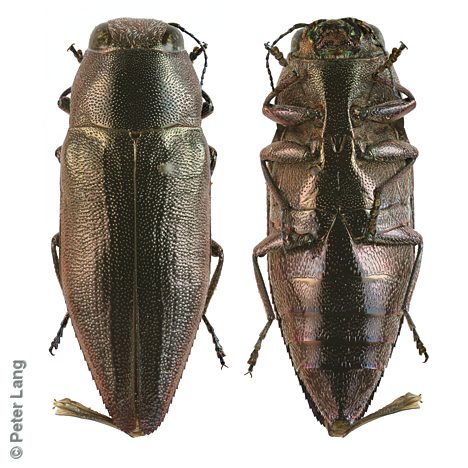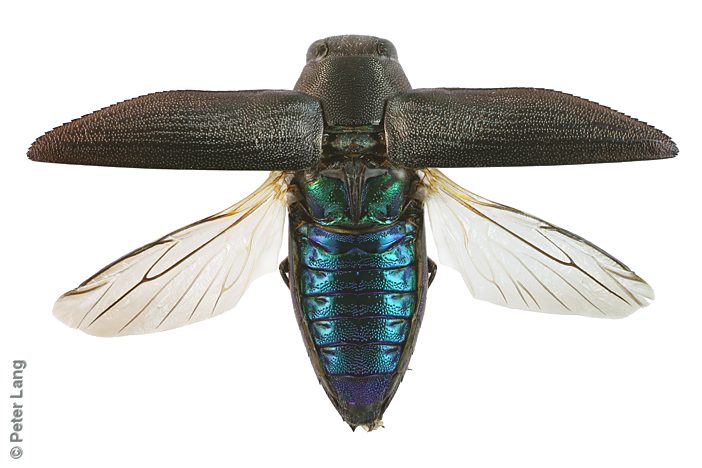

size¹:
×
4.8 mm


| female | ||||||
|---|---|---|---|---|---|---|
| L1 | 13.3 | 12.8 – 14 | n = 5 | |||
| L2 | 12.6 | 12.45 – 12.85 | n = 2 | |||
| W | 4.8 | 4.4 – 5 | n = 5 | |||
| Legend | L1 | length from clypeus/frons to elytral apex (mean, range, sample size) |
| L2 | length from anterior of edge of eyes to elytral apex | |
| W | maximum width with elytra fully closed |
Bronze to dark grey-bronze colouration and a broad, thick body shape. Head with a shallow depression medially at the junction of the anterior frons and clypeus, a feature unique within the species group (Levey 2023). Readily distinguishable from M. sordida by the puncta of the medial pronotum not being transversely elongated, and from M. soror soror by the rather weak elytral costae.
Named by Blackburn 1887 after a Mr. Rothe of Sedan (in the MU Region against the eastern margin of the Mt Lofty Ranges) from whom he received a collection of this species.
In the protologue, Blackburn 1887 commented that "the peculiar form of the thorax distinguishes this insect from all other species that bear any resemblance to it" and drew attention to "the prosternum a little elevated across its front margin instead of being declivous". These features are difficult to interpret.
Until November 2020 Melobasis rothei was included on these pages within the entity Melobasis sp. Brown. I am grateful to Brian Levey (2020, pers. comm.) who identified the images shown here as being M. rothei, having previously seen the type and matched specimens of this species against it.
| Legend | P.J.Lang collection vouchered records | |
| other private collection or museum specimens, or sightings |
|
|
|
|
|
|
|
|
|
|
|
|
|
||||||||||||||||||||||||||||||||||||||||||||||||
|
|
|
|
|
|
|
|
|
|
|
|
|
||||||||||||||||||||||||||||||||||||||||||||||||
| Jul | Aug | Sep | Oct | Nov | Dec | Jan | Feb | Mar | Apr | May | Jun |
| Legend | ||
9 | number of active beetles, actually recorded in that quarter-month | |
| actual count > 2.5 (mean) | ||
| actual count <= 2.5 (mean) | ||
| beetles | sites | SA regions¹ | family | position on host plant | ||
| Senna artemisioides ssp. filifolia | 3 | 2 | MU | F | ||
| Senna artemisioides ssp. petiolaris | 2 | 2 | EP, MU | F |
| Legend | beetles | count of beetles collected from, or sighted on, host plant taxon |
| sites | count of major sites (unique 10 km grid cells +/- some distinct approximate localities) | |
| Plant names in green are hyperlinked to a matching host species page with plant photos. | ||
| Code | beetles | % | host plant taxa | |
| F | Fabaceae | 5 | 100% | 2 |
| position | beetles | sites | |
| on foliage or non-flowering plant | 5 | 3 |
Levey 2023 reports that adults have been collected from foliage of Senna and Acacia species. My collections in SA have all been from Senna artemisioides.
| ¹ Legend | regions | SA State Herbarium regions (map) EA: Eastern, EP: Eyre Peninsula, FR: Flinders Ranges, GT: Gairdner-Torrens, KI: Kangaroo Island, LE: Lake Eyre, MU: Murray, NL: Northern Lofty, NU: Nullarbor, NW: North-Western, SE: South-Eastern, SL: Southern Lofty, YP: Yorke Peninsula |
| size | The ellipse is the correct size when printed, indicative on a desktop screen, and likely to be wrong on a mobile device. |